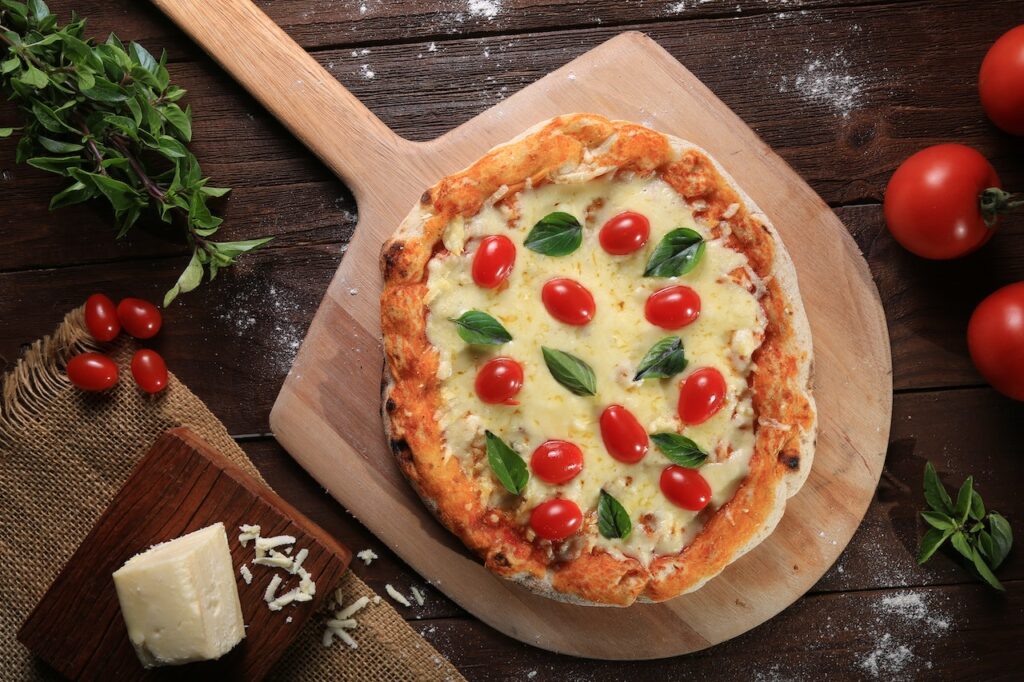Do you want to add spices and herbs to your delicious DIY pizza recipe? It takes more than just good dough and tasty toppings to make the ideal pizza; fragrant herbs and spices take this time-honored cuisine to a whole new level. These colorful additions, which range from spicy chili flakes to fragrant basil, give each slice a blast of taste and individuality.
This post will take you on a tasty trip as we explore various spices and herbs that may transform a simple pizza into something amazing. So, strap up and get ready to excite your taste buds as we reveal the techniques for using spices and herbs to create a pizza masterpiece. It will motivate you to explore, think outside the box, and turn your pizza creations into culinary wonders that will have everyone clamoring for more, whether you’re a seasoned pizza enthusiast or an inexperienced home chef.
Why Are Spices and Herbs Added to Pizza?

Spices and herbs enhance the flavor of pizza and make it more delightful to consume. Here are some of the reasons why spices and herbs are frequently used in pizza:
➤Flavor Enhancement
Spices and herbs have different tastes that can enhance the flavors of other pizza components. For example, Oregano, basil, and thyme are typical herbs that give freshness and richness to the overall flavor of the pizza. For those who want a little heat, spices such as red pepper flakes or chili powder can offer a spicy kick.
➤Aromatics
Many spices and herbs have fragrant components that may provide intriguing aromas when combined with pizza. By stimulating the senses and creating the pizza more attractive, the scent of these components can improve the whole eating experience.
➤Regional and Traditional Preferences
Traditional or regional tastes affect the usage of particular spices and herbs on pizza. In Italian cuisine, for example, oregano is a famous herb used on pizzas, particularly Margherita pizza. Similarly, various areas may utilize their own distinct spice blends or herb combinations on their pizzas, contributing to pizza toppings’ cultural and geographical diversity.
➤Personal Preference
Finally, adding spices and herbs to pizza is a matter of personal preference. Some individuals love experimenting with various flavors and combinations to make a pizza that meets their tastes. Adding spices and herbs enables customization and the creation of a one-of-a-kind and delectable pizza experience.
While spices and herbs are widely used on pizza, the choice of which of them to use is subjective and can vary based on personal taste and regional customs.
Best Spices and Herbs for Pizza

Pizzas are not just delicious and a popular dinner for millions of people but also flexible. Pizzas are especially beneficial for families that wish to add more spice’ to their meals but are still determining where to begin. Although it’s fun to experiment, certain herbs for pizza taste better than others. The greatest pizza spices are oregano & pepper, but there are many more to try.
Here’s our list of the best spices and herbs to add to homemade pizza to provide something special that only comes from preparing it yourself.
🌿Garlic
What could be a more delicious pizza topping than roasted garlic? It will give your pizza a lot of additional flavors and may be used on vegetarian and carnivorous pizzas. Garlic goes exceptionally well with tomatoes, chicken, & cheese pizzas.
🌿Oregano
Here we have a common and beloved culinary essential. It has a distinctive savory flavor may give your pizza a light flavor. One of our favorite Italian herbs for pizza is oregano since it’s important in Italian cuisine. For a wonderful outcome, add pepperoni & spinach to a pizza along with oregano.
🌿Red Pepper
Crushed red pepper should be noticed by diners who want their cuisine especially spicy. Using this spice will transform your handmade pizza into a mouthwatering culinary adventure. You’re sure to like the dish since it’s not extremely spicy yet has a great bite. A delicious choice is a pizza with mozzarella cheese, ground beef, & crushed red pepper. Red pepper pairs well with mozzarella cheese & basil on a vegetarian pizza.
🌿Parsley
Chopped parsley’s distinctive bitter yet fresh flavor will enhance any handmade pizza’s flavor. Because of this, it’s a fantastic and obvious option regardless of the other things you want to use on your pizza. Parsley is a fantastic partner for spicy lamb, cumin, paprika, & red onions on a handmade pizza.
🌿Thyme
Thyme is the last herb on our list of the top ones for pizza. This leafy herb has a mild sweetness and can be the flavoring element you’ve always wanted but have yet to think to add. Your family will love the flavor of a pizza with wild mushrooms, fontina cheese, and oregano; you can guarantee they’ll want it again. You may also get a pizza with pepperoni, honey, thyme, ricotta cheese, cherry tomato, thyme, and mozzarella.
🌿Basil
Because they both belong to the mint family, basil & oregano are essentially relatives. Both are remarkably similar, so much so that you may substitute basil for oregano in virtually all recipes. The herbs blend well with the savory components often used to make pizza since they complement one another. But there is also a significant difference. Due to licorice undertones, basil has a sweeter note than oregano. It also has a minty and herbaceous taste. Consider it as being comparable to other herbs like thyme and dried mint.
It may be used as a topping or while making the pizza’s tomato sauce. For better flavor and look, use fresh leaves in the latter scenario. Additionally, after stacking leaves on top of one another and rolling them into cylinders, cut the herb as thinly as possible using a premium knife to make it even more delectable.
🌿Rosemary
If you want some major flavor on your pizza, rosemary should be your go-to spice. Rosemary has a sharp pine taste and a tangy, woodsy scent, with pointed leaves and woody stems. Even if rosemary isn’t one of the more often-used pizza ingredients, you may still use it to make the sauce. It would help to use rosemary to top your pizza with Italian sausage or meat pieces. However, unlike basil, you shouldn’t use rosemary as a fresh topping.
🌿Black Pepper
Without a doubt, one of the most frequently used spices worldwide is black pepper. The taste characteristic of this spice is difficult to describe since it is simultaneously harsh, piney, and woody. It is unmistakably earthy and has a distinctive pungent flavor that makes it spicy and biting. For this reason, black pepper may be a great addition to your pizza dough.
All the above flavors and garnishes are excellent, but they are much more flavorful when combined. We advise doing a few test runs with seasoning the pizzas to get the finest taste combination that suits your palate since each condiment carries a distinct punch & brings out its distinctive taste. However, if that seems too much effort, you can always get a generic Italian seasoning blend from a shop that combines several herbs. You could even manufacture your pizza spice blend to have it on hand in your pantry.
Popular Seasonings to Try on Your Pizza
It’s remarkable how much flavor salt and spice can bring to a dish, even pizza. In one of our most recent blog entries, we listed the top sauces to sprinkle over your slices to bring out the dish’s cheesy, saucy flavor. There are, however, a lot more methods to improve your pie.
Try dusting these various spices, sprinkles, and herbs on top of your pie rather than dipping a piece into a dip. Diverse of these recommended accessories will either give your taste receptors a delightful jolt, boosting the dish’s diverse tastes. Therefore, consider exploring these condiments in your home before placing your next pizza order.
🍕Dried Oregano
Oregano, a typical Italian herb, gives your pizza a sweet and earthy flavor. The herb gives the pie an immediate lift by enhancing some of the tomato sauce’s characteristics. If you try oregano, we suggest pairing it with a pizza with more conventional toppings.
🍕Parmesan Cheese
A few sprinkles of parmesan cheese may be an excellent place to start if you have hesitated to add more toppings to your pizza since it just slightly alters the taste. Your slice of parmesan cheese will taste strong yet satisfying because of the matured cheese quality. Use widely, but be careful not to use excessively. There is such a thing as too much cheese on a pizza slice. The nicest Parmesan would be freshly grated, although cheese sprinkled in a bottle may also work.
🍕Powdered Garlic
Pizza pairs well with garlic because it adds a deliciously crisp and sweet taste. To give your meal more complexity, liberally sprinkle it with garlic powder. Like Parmesan, garlic is a fantastic introductory flavor for pizza lovers who may hesitate to season their slices.
🍕Crushed Red Pepper
Red pepper flakes are the perfect condiment if you want some heat. These flakes will provide your pie an immediate taste enhancement with delectable zing and give your toppings a crispy texture. Crushed red pepper is a great option for novices who wish to try hotter cuisine but may have a lesser tolerance for any heat. Nevertheless, if you don’t often eat spicy cuisine, use sparingly.
🍕Fresh Basil Leaves
Pizza Margherita often includes fresh basil leaves, and for a good reason. Consider using a few basils leaves in your next pie if you have any basil growing in your yard the next time. The plant gives the food a sweet but fresh taste with its licorice scent.
🍕Chopped Parsley
Pizza will become more elegant when garnished with chopped parsley because of its freshness and bitter flavor. The herb, a relative of cilantro, is a common addition to pasta and risotto and aids in bringing the tastes together. Make careful to cut the parsley finely and softly sprinkle it all over the pie.
Benefits of Adding Spices and Herbs to Your Pizza

Adding spices and herbs may improve your pizza’s taste profile, which will also improve your eating experience. Here are some advantages of adding herbs and spices to your pizza:
☑️Improved Taste
The use of herbs and spices enhances your pizza’s taste. They may enhance the flavor by giving it a nice bite, warmth, or complexity. You may alter the flavor of your pizza to your liking by adding different spices and herbs.
☑️Aromatic Appeal
Herbs and spices have intriguing aromas that may pique your interest and senses. Seasoning your pizza with herbs and spices like basil, oregano, garlic, or chili flakes releases their aromas during baking, improving the sensory experience.
☑️Digestive Aid
Ginger, fennel, & oregano are a few herbs and spices that have digestive qualities and may help with digestion. If you include them in your pizza, they may aid digestion after a meal.
☑️Antioxidant Properties
Antioxidants, good for general health, are prevalent in many herbs and spices. For instance, oregano is rich in antioxidants, so adding it to your pizza might increase the amount of these beneficial elements.
☑️Health Advantages
Various herbs and spices have various health advantages. For instance, turmeric has anti-inflammatory qualities, while garlic and onions are recognized to have antibacterial & antiviral characteristics. Increase your pizza’s nutritional value by adding these things.
☑️Variety and Experimentation
You may experiment with various taste pairings and make one-of-a-kind, customized pizzas by adding spices and herbs. The alternatives are limitless, whether you like a spicier pizza with chili flakes or more fragrant with basil and oregano.
☑️Reduction of Salt and Fat Consumption
You may use spices and herbs to lessen the need for excess fat and salt in your pizza. This may provide a healthier pizza choice without sacrificing flavor for people managing their salt or fat consumption.
☑️Cultural Influence
The traditional spice and herb combinations used in creating pizza vary depending on the location and culture. For instance, oregano and basil are often seen on pizzas made in the Italian style, but chili flakes & oregano may be more popular in the New York style. These cultural elements help make the food more appealing and enjoyable overall.
It’s crucial to achieve a balance when adding herbs and spices to your pizza and make sure the tastes work well together. Experimenting with various ratios and mixtures is advisable to get the optimal flavor combination for you.
How to Make Homemade Pizza Seasoning Recipe
This DIY homemade pizza seasoning recipe is a delicious present that takes a few minutes to prepare—the pizza spice blend in a glass jar with a ribbon on top. Finally, the time of year when we can start planning what to get those we love for the holidays, has been here. Handmade presents like this recipe for pizza seasoning are wonderful, and I know your loved ones feel the same way.
Pizza seasoning created from scratch is a fantastic method to make your pizzas taste even better. Here is a straightforward method for making homemade pizza seasoning:
🍛Ingredients
◾️Dried oregano, two teaspoons
◾️Dried basil, two teaspoons
◾️1/fourth cup dried thyme
◾️One teaspoon of rosemary, dry
◾️1/4 cup dried marjoram
◾️One tablespoon of powdered garlic
◾️1 teaspoon of onion powder
◾️One teaspoon of optional red pepper flakes
◾️One teaspoon each of salt and pepper
🍛Instructions
All the dried herbs and spices, including oregano, basil, rosemary, thyme, marjoram, onion powder, red pepper flakes, garlic powder (if used), salt, and black pepper, should be combined in a small bowl.
Everything should be fully blended after mixing. Use a spoon or your hands to remove any clumps and ensure the ingredients are distributed evenly.
Try a little amount of the spice and tweak the tastes to your liking. To suit your taste, you may increase the amount of salt, pepper, or any additional herbs or spices.
Transfer the seasoning mixture to an airtight container or spice jar with a tight-fitting cover after you are pleased with it.
For easy future reference, mark the container with the name and date.
The homemade pizza seasoning should be kept out of direct sunlight in a cool, dry location. It ought to stay tasty and fresh for many months.
🍛Usage
Sprinkle the homemade pizza spice over your pizza before or after baking to use it. Additionally, you can season other Italian foods like spaghetti, garlic bread, and salads with it and include it in your pizza sauce.
To make your ideal pizza seasoning mix, experiment with various herbs and spices, as handmade seasonings let you tailor the flavors to your preferences. Enjoy your handmade pizzas seasoned with your wonderful spice!
Health Benefits of Adding Spices and Herbs to Pizza

In addition to enhancing pizza taste, spices and herbs may provide several health advantages. Here are some typical pizza toppings, along with the health advantages they bring:
👍Basil
A, K, and C vitamins, as well as minerals such as magnesium & potassium, are all abundant in basil. It contains anti-inflammatory effects and antioxidant qualities. Additionally, basil contains essential oils with antibacterial capabilities.
👍Oregano
Strong taste and scent are two characteristics of oregano. It includes several antioxidants, including thymol and rosmarinic acid, which may help guard against cell damage brought on by free radicals. Additionally having antibacterial qualities, oregano also has the potential to be antiviral and antimicrobial.
👍Garlic
A common spice included in pizza sauce and toppings is garlic. Allicin, a substance found in it, has antibacterial qualities and may strengthen the immune system. Additionally, garlic is thought to provide heart-health advantages, including lowering blood pressure and raising cholesterol.
👍Thyme
Thymol, a substance having antibacterial and antifungal effects, is present in the plant thyme. Antioxidants, vitamins C & A, and minerals like iron & manganese are all abundant in them. Thyme has been utilized in traditional medicine for coughs & congestion and may promote respiratory health.
👍Red Pepper Flakes
Red pepper flakes give pizza a fiery bite. They contain capsaicin, a compound with anti-inflammatory and possibly analgesic properties. The metabolism-boosting properties of capsaicin may assist with weight control. Enhancing blood flow and lowering blood clot formation may also positively affect the cardiovascular system.
👍Rosemary
Antioxidants found in rosemary include rosmarinic acid & carnosic acid. Rosemary is a fragrant plant. It could aid with digestion and has anti-inflammatory qualities. Rosemary has been linked to cognitive advantages and may improve focus and memory.
👍Black Pepper
Piperine is a substance found in black pepper, a popular spice. Research has been done on the possible anti-inflammatory and antioxidant properties of piperine. Additionally, it could improve digestion and nutritional absorption.
Although some spices and herbs may have health advantages, it’s crucial to remember that they usually result from taking far more of them than you may find on a slice of pizza. Consider adding these spices and herbs to other recipes and meals to enhance the health advantages.
Tips on Making Homemade Pizza
◾️When creating dough, use active dried yeast that is fresh. Quality olive oil, warm water, some honey or another sweetener, and sea salt should be added to the dough as a food source. Give your dough plenty of time to rise, about an hour.
◾️Completely preheat your oven. Typically, recipes call for at least 400 degrees Celsius.
◾️Bake the pizza at a lower temperature for longer if you desire a soft crust. Cook it for a shorter time at a higher temperature to get a crispy crust.
◾️Position your pizza pan on the oven rack in the center of the oven.
◾️Check if the crust is browning on the outside and if the cheese is completely melted to determine if it is finished.
◾️Consider grilling your pizza for a smokey taste. It takes 15 – 20 minutes at 400 degrees. Add a barbecued ingredient to your sauce, like the Frontier Barbecue ingredient.
◾️Spices may be used in your sauce or even the dough and sprinkled on top of the pizza. Consider adding fennel, sesame seeds, garlic powder, or Italian spice.
◾️Before spreading the dough, gently grease your pizza pan—most pizza chefs like olive oil.
◾️Try different baking surfaces. Some pizza chefs believe a pizza stone is necessary to make a flawless pie. Others use pizza screens or pans with holes on the bottom that let the dough’s bottom surface cook smoothly. Others use a standard pizza pan that has been dusted with cornmeal.
◾️Attempt various sauces. Alternatives to the typical pizza sauce include spaghetti sauce, marinara sauce, Alfredo sauce, pesto, & even melted butter with herbs and spices (including basil, rosemary, thyme, garlic, and parsley).
Pizza Seasoning Recipe
Fortunately, the simplest pizza seasoning recipe is effective. Ingredients must be measured and combined by whisking or shaking. Mixing herbs, spices, and aromatics is the secret to creating the perfect pizza flavor. You may pulse them in a blender or food processor to make them more delicately powdered, or you can leave them as is, as I do.
Let’s quickly review the materials and tools required to prepare our pizza seasoning mixture. As with any handmade spice mixture, you may adjust it to your preferences, but this is the same mixture always in a jar in my house. It should be clear that oregano is the main component of this dish. On it, the whole spice combination is based!
The recipe directs the use of basil, Italian spices, or marjoram. I use marjoram constantly. It lends a beautiful touch to many Italian, Greek, and other Mediterranean cuisines, and it is a lesser-known dried herb. You may choose what to use depending on what you have on hand and what you want. All three of the ways I prepared it were delicious.
Leave out the salt to get a salt-free mix if you want one. And I adore using smoked paprika in our mix, but if you have plain paprika or prefer it, you may use that instead.
Let’s spend a bit discussing the parmesan cheese. There’s a time and a place, I often tell folks when I direct them away from powdered parmesan-type cheese. You all, then. This is the right moment and location! For this, don’t use freshly grated cheese. It will swiftly spoil and have the propensity to clump.
Frequently Asked Questions
What kinds of herbs are utilized in pizza?
When creating handmade pizzas with the family, ‘Italian herbs’ or ‘Italian seasoning,’ which consists of oregano, dried basil, parsley, thyme, rosemary, chili flakes, and garlic powder, works very well.
What ingredient gives pizza its distinctive taste?
Basil & oregano, both members of the larger mint family, are the foundational ingredients of pizza spice. While oregano’s harsher, pepperier pungency pairs well with the spiciness of your toppings, basil’s delicately fragrant aroma brings out the sweetness & fruity notes in your tomatoes.
Can fresh herbs be used on pizza?
Toss the arugula, entire basil leaves, parsley, extra virgin olive oil, and balsamic vinegar in a bowl. Sprinkle-grated Parmesan on top of the pizza after scattering the toppings.
Which herbs do Italians use while topping pizza?
Dried oregano, basil, thyme, and rosemary are combined to make Italian spice. Onions, garlic, fennel, and other added ingredients that everyone enjoys with their pizza are often included in pizza seasoning.
What gives pizza its flavor?
I like brushing the dough with butter, salt, garlic powder, parmesan cheese, & parsley to flavor my pizza. Amazingly, a little seasoning can make a pizza taste so much better! Although butter usually tastes the finest, you could use olive oil instead.
Final Words
The tastes and smells of homemade pizzas are greatly enhanced using spices and herbs. You can turn your pizza from average to spectacular by carefully choosing and mixing these components. Each mouthful may be enhanced with depth, complexity, and a hint of freshness by using the correct combination of spices and herbs. You can make each slice of your homemade pizza uniquely yours by putting spices and herbs in it. These savory toppings can transform an average pizza into a gourmet masterpiece, whether you’re throwing a pizza party or spending a peaceful night. To create your perfectly seasoned pizza, embrace your imagination, let your taste senses guide you, and enjoy the process. Do you want to know best herbs for tuna salad? Click Here!

